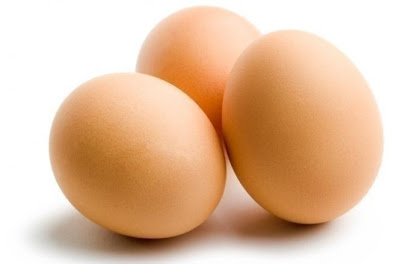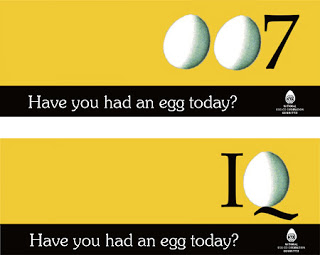campaign called ”Sunday ho ya Monday roz Khao ANDE”
staple from time
immemorial and for all good reasons. Afterall, an egg is a storehouse of vital
nutrients, making them an integral part of a healthy diet. And for those of you
who are afraid of indulging in this power food because you’re worried that it
will add to your weight, remember, one egg contains about 80 calories and about
five grams of fat. Hence, smart
consumption is a far healthier option to cutting them out
completely.
reputation from reports they contribute to raised
cholesterol.
Eggs are a well-known
rich source of protein — an important building block of bones, muscles, cartilage, skin, and blood. The body
uses protein to build and repair tissues as well as making enzymes, hormones
and other body chemicals. Unfortunately, unlike fat and carbohydrates,
the body does not store protein, and therefore has no reservoir to draw on when
it needs a new supply. Thus eggs are the perfect sources and a smart food
choice for those who reduce their intake of carbohydrates in a bit to lose
excess weight.
Another important
nutrient you’ll find abundantly in egg white is riboflavin or Vitamin B2. And for all of you wondering what’s the
benefit of this nutrient, Riboflavin is
a water-soluble vitamin which is involved in vital metabolic processes in the
body and is necessary for normal cell function, growth, and energy production.
to cholesterol consumption. Fat from healthy sources is vital to the body,
while fat from poor choices, such as margarine or foods fried in vegetable oil,
are very dangerous. Eggs remain a beneficial source of healthy
fat. Many nutrients, such as vitamin A, are better absorbed with fat,
making eggs a very good source of vitamin A.
The
yolk, which many of us avoid out of fear, is actually a very healthy food, if
consumed in moderation. Mainly fat, the yolk contains 1.33 gm of cholesterol
per 100 gms and is a rich source of vitamin A, B vitamins, calcium,
phosphorous, lecithin and iron. Incidentally, the iron found in the yolk is
easily digested and assimilated in the body. According to nutrition experts,
one can eat one whole egg every day without harming one’s cholesterol and other
blood-fat levels. But for those who crave for more eggs, you can reduce fat by
using one whole egg and the whites of the rest of the eggs.
And
now for all the ways you can eat them. There are four basic ways in which eggs
can be prepared. They are us under:
Boiled
many of us, this is a comfort food that brings back yummy childhood memories.
Boiling an egg is one of the healthiest way you can consume it and is the
perfect option for those watching their weight. To make the perfect boiled egg,
drop the eggs in their shells (preferably at room temperature) into simmering
water, and cook for three to 10 minutes on a medium flame. Here’s the
interesting part. A short cooking time produces a soft boiled egg, with a runny
yolk while boiling the eggs for a longer time will give you a nice hard boiled
eggs, which can be eaten plain, sliced, mashed and even added to variety of dishes.
Poached
may have heard the term often and wondered what exactly the hype is all about.
Well, to put it simply, a poached egg is one that has been cooked by poaching
it in water. Like a boiled egg, this too is an oil free preparation method. To
poach an egg, let water simmer in a pan. Crack the egg into a small bowl and
then gently slid it into the pan. Cook the egg until the white has solidified
but make sure the yolk remains soft. The ‘perfect’ poached egg has a runny
yolk, with a hardening crust.
Scrambled
toast, now that’s what a perfect American breakfast consists of. This
preparation of eggs is an all-time favourite with kids. For the perfect
scrambled egg, all you need to do is whisk up the eggs in a bowl before pouring
them into a hot pan. Whisking will make the batter airy resulting in a light
and fluffy preparation when done. Once you pour the batter into the pan, allow
it to set for a few seconds and them stir through it and scramble it up. You
can add a variety of ingredients like fine chopped vegetables, cold meats,
shredded chicken or cheese for more texture and flavour. These can either be
mixed into the batter or served as a side dish. Alternatively, pour the egg
batter into a hot pan, allow it to settle and cook for a while, arrange the
ingredients in a neat line at the centre and then fold the edges over. Cover
the pan and let this cook for a minute or two on a slow flame.
eggs, finely chopped onions, tomatoes, chillis and coriander.
Fried
Last but not the
least, is the the fried egg. For many of us who are forever racing against time
nothing makes for a more filling meal than a couple of fried eggs jammed
between slices of bread. Fried eggs are made by cracking the egg into a hot,
oiled pan. In fried eggs too, one can either go for the egg well done or for
sunny side up. In the former version, the egg is fried well on both sides thus
ensuring that both, the white and the yolk are cooked. For the latter, the eggs
are left to cook on one side only. Thus, while one side of the egg gets cooked,
the top side, especially the yolk remains runny. To get the perfect sunny side
up, heat oil in a pan. Crack the eggs into it taking care not to break the
yolk. Let it cook for about five minutes or till the whites by the yolk are
cooked to your choice. Slide the eggs off carefully into a plate.
Here’s how the nutrition in an egg can
be broken down: A hen’s egg of 60 gms consists of:
7.9 gms of protein
7.9 gms of fat
103kcl
36 mgs of calcium
132 mgs of
phosphorous
1.26 mgs of iron
healthy food !




Almost complete info abt eggs! 🙂 great…